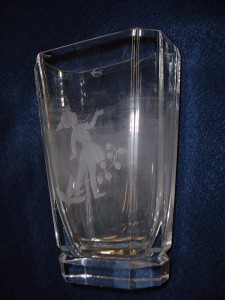We decided that our weekly blogs are going to be informational. You will be seeing a lot of “How To” in regards to antiques, art and auctions. Your input for ideas is always welcome, just send us a message on our Contact Us page. Also, if you want an expert’s opinion, there are a number on our Community message board. You can sign up for free and post a picture under What Is It Worth?
There are many things to consider when collecting glass. First, we decide why we are collecting it. Is it because we saw something at a friends that caught our eye, or did we inherit a set of dishes when grandma passed away? Did we read in a magazine about the increase in value of art glass over the years and decide that while the stock market is down, we will park our money in a different type of “investment”.
Once we have chosen a style of glass we like and can afford, we look to educate ourselves further about when it was made, what the company made and where we might find more. Fortunately, your local bookstore offers an abundance of books on collecting all patterns and periods of glassware to help you. These books often provide background information and history of the manufacturer, patterns and pieces that were made by the company and during what time period. Many of these books, depending on the type of glass, offer a price guide of sorts to help you get a basic idea of what to pay for additional pieces you find in your travels.
The one thing the books might not mention is condition. Condition can be a major factor in the value of any piece of glassware. Most collectors are purist. By that, we mean they want things in mint condition, as if they just came off the showroom floor. No chips, cracks, roughness or sickness. The only exception to this rule is extremely rare pieces. Condition is still of importance, but because of a crack or chip, collectors are still interested in the piece because of its rarity.
Chips sometimes can be repaired if they are not too large or too deep. A local glass repairman (or glass grinder) can polish them smooth. As for cracks, there is little that can be done. Roughness many times is found in Depression glass, or other mass-produced glassware made from a mold. Mass produced glass is often poor quality and has flaws that were overlooked when finishing.
Sick glass, or cloudy glass as it is often called can sometimes be remedied.
 Cloudy glass is an industry word describing glass that has calcium deposits which causes a light “foggy” type appearance in glassware. The water that held the flowers in the vase or the repetitive washing of the tumbler is the culprit. They need not stay in this condition. There are several ways to bring that vase back to its original lustre.
Cloudy glass is an industry word describing glass that has calcium deposits which causes a light “foggy” type appearance in glassware. The water that held the flowers in the vase or the repetitive washing of the tumbler is the culprit. They need not stay in this condition. There are several ways to bring that vase back to its original lustre.
Over the years collectors have reported a number of household products that they have found cleaned the lightest, to the heaviest hard water stains. Below are just a few of them.
- Fill the object with a mix of ammonia and water. A few hours should do the trick if the stain is not too thick.
- Vaseline or petroleum jelly can sometimes remove light calcium build-up. Let it sit for 4-5 days before removing.
- Fill with luke warm water and drop in a denture cleaner tablet.
- Pearl Drops Toothpaste has been recommended for light calcium stains. Dab a little on your index finger and lightly rub. Wash with water.
- Dow Tub and Tile cleaner. Spray on, let sit, then rinse.
- There is a product in the supermarkets called Krazy Kloth. It is highly recommended for the toughest hard water stain. Follow the directions on the packaging, and wash with luke warm water.
- Lime Away. The same product you use on your tub and shower doors. Always remember for products that require rubbing to do it lightly and in small circles.
Remember, never wash glassware with cold or hot water. Extreme temperature changes can cause glass to crack or shatter. Also, glassware should not be placed in the dishwasher. Again, hard water stains will eventually appear, and there is also the possibility the vibration of the dishwasher can cause a piece to shatter. The best way to clean your glass is to wash by hand, always with luke warm water and mild dishwashing soap (liquid), and towel dry.
Often, great pieces of glass are passed upon at shows and shops because of their cloudy appearance. If the price the piece is being offered to you is reasonable, don’t pass it by!
This is a very helpful article, thanks!!
Do you have any suggestions for fixing scratched glass?
I suggest contacting a glass restorer in your area and have the item looked at. It is hard to say if scratches can be restored or not. It depends on how deep they are.
Reyne